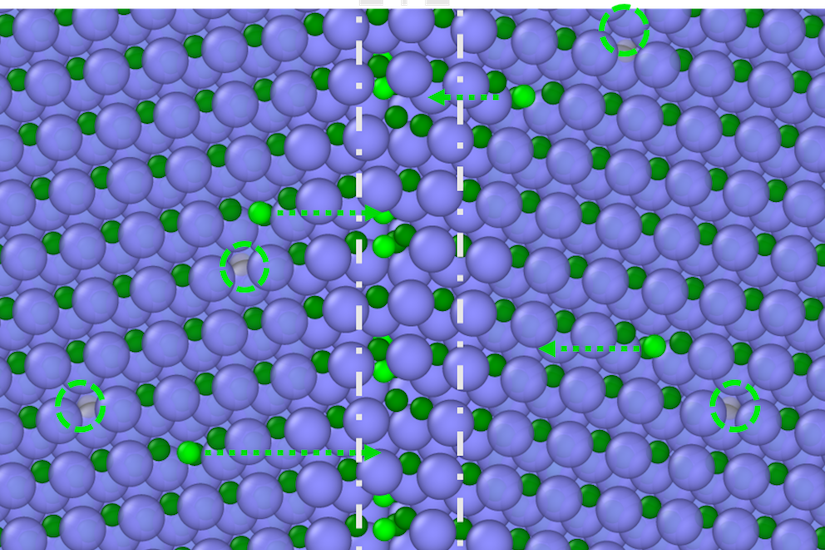May 26 2020
When thinking of ceramics, a majority of the people would imagine their favorite flowerpot or mug. However, contemporary technology is flooded with sophisticated ceramics, ranging from ceramic superconductors to silicon solar panels and biomedical implants.
 This image illustrates that, after irradiation, loose carbon atoms move toward the grain boundary in silicon carbide. Image Credit: Hongliang Zhang.
This image illustrates that, after irradiation, loose carbon atoms move toward the grain boundary in silicon carbide. Image Credit: Hongliang Zhang.
A majority of those sophisticated polycrystalline ceramics are a mixture of crystalline grains that look like a stone fence held together with limestone mortar, at the microscopic level. Similar to that stone fence, the strength of the mortar determines the strength of the ceramic; in ceramics, mortar refers to the grain boundary, or the regions where the different grains conjoin together.
In the past, many scientists assumed that these grain boundaries in ceramics have highly stable chemistry. However, according to a recent study performed by materials science engineers at the University of Wisconsin-Madison, that is not the case. When the material is subjected to radiation, carbon atoms accumulate at the grain boundaries of the crucial ceramic material silicon carbide.
This discovery may aid engineers to gain a deeper understanding of the properties of ceramics and may help perfect a new range of ceramic materials. The study results would be published in the Nature Materials journal in June 2020.
From the 1970s, scientists have known about similar segregation in metal alloys caused by radiation. Metal atoms can mix and unmix easily because they share electrons freely.
When metal atoms are hit by ion radiation, a few of the atoms within the metals will come out of place and will travel toward the grain boundaries; however, if different types of atoms travel at different speeds, it becomes easy to alter the alloy’s chemistry.
But in ceramics, atoms are extremely choosey about the type of neighbors they couple with and the bonds are relatively stronger when compared to that of metals. That is the reason why the scientists assumed that these atoms were not exposed to the same kind of segregation.
However, when Izabela Szlufarska, a professor of materials science and engineering at the University of Wisconsin-Madison, started to closely examine the grain boundaries of silicon carbide, that is not what she discovered.
In silicon carbide, the silicon and carbon really want to be paired together; they want to be 50 percent carbon and 50 percent silicon.
Izabela Szlufarska, Professor, Department of Materials Science and Engineering, University of Wisconsin-Madison
But when Szlufarska’s research team ran simulations and then imaged the grain boundaries, the concentration of carbon was found to be just 45% at the grain boundaries.
The chemistry was just really off. That was the first surprise, since this material really wants to have ordered atoms.
Izabela Szlufarska, Professor, Department of Materials Science and Engineering, University of Wisconsin-Madison
This implied that silicon carbide might also be sensitive to segregation caused by radiation. Therefore, Szlufarska and her research team used ion radiation to bombard the substance and found that the grain boundaries experienced carbon enrichment between 300 °C and 600 °C.
At such energy levels, the radiation forces a few carbon atoms to come out of place and produces a couple of defects in the silicon carbide, including a loose carbon atom known as an interstitial and an empty spot known as a vacancy. Those unbound interstitial atoms shift to the grain boundaries in which they build up and ultimately impact the chemistry of the material.
The scientists simply did not believe that this kind of segregation actually occurs in ceramics. And added to this fact, they also did not have the tools to even analyze the phenomenon, informed Szlufarska.
After meticulous preparation and fabrication of the silicon carbide bi-crystals, advanced scanning transmission electron microscopy performed at Oak Ridge National Laboratory and the University of Wisconsin-Madison enabled the researchers to overcome the chemical composition along the grain boundaries.
According to the researchers, the phenomenon may also take place in other types of polycrystalline ceramics. The process is regarded as a double-edged sword—on the one hand, the segregation induced by radiation means that ceramics are prone to the same kinds of deterioration and damage at their grain boundaries just like metal alloys, albeit at varying temperatures.
On the other hand, the radiation-induced segregation may prove handy in materials engineering to create dedicated models of ceramics such as silicon carbide, which is employed in jet engines, nuclear energy, and other advanced applications.
Maybe the radiation can be used as a tool to fine tune grain boundary chemistry. That could be useful to us in the future.
Xing Wang, Study Co-Authors and Assistant Professor, Pennsylvania State University
Izabela Szlufarska is the Harvey D. Spangler Professor of Engineering in materials science and engineering and engineering physics at the University of Wisconsin-Madison.
Xing Wang (currently an assistant professor at Pennsylvania State University) and Hongliang Zhang from the University of Wisconsin-Madison are the study’s co-authors and contributed equally to the article.
Other authors from the University of Wisconsin include Tomonori Baba, Hao Jiang, Cheng Liu, Yingxin Guan, Omar Elleuch, Milton J. and A. Maude Shoemaker and Beckwith-Bascom Professor Emeritus of Chemical and Biological Engineering Thomas Kuech, Harvey D. Spangler Professor in Materials Science and Engineering Dane Morgan, and Beckwith-Bascom Professor in Materials Science and Engineering Paul Voyles.
Other authors include Juan-Carlos Idrobo of the Center for Nanophase Materials Sciences at Oak Ridge National Laboratory.
The researchers acknowledge the US Department of Energy Basic Energy Sciences for financially supporting this study (fund number DE-FG02-08ER46493). The team also acknowledges the use of instrumentation and facilities supported by NSF via the University of Wisconsin Materials Research Science and Engineering Center (DMR-1720415).
The electron microscopy study was carried out as part of a user project via the Center for Nanophase Materials Sciences at Oak Ridge National Laboratory.
Journal Reference:
Wang, X., et al. (2020) Radiation-induced segregation in a ceramic. Nature Materials. doi.org/10.1038/s41563-020-0683-y.